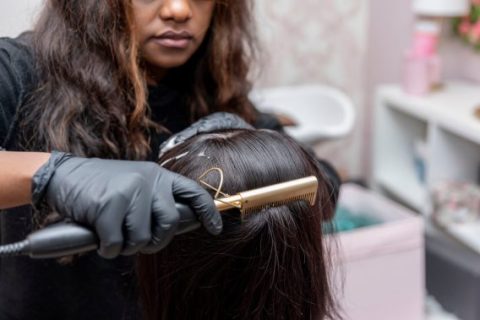How Workplace Hair Discrimination Can Impact the Health of Black Women
Black girls and women have long faced hair discrimination at school and the workplace. But using chemical hair straighteners to conform to both spoken and unspoken rules comes at a great cost: Scalp damage, pain and an increased risk of developing uterine cancer.


Chemical Hair Straighteners: From Discrimination to Cancer
For many Black girls and women, straightening their natural hair has served as a way to avoid hair discrimination and bias at school and the workplace. Natural hair is hair that hasn’t been altered by chemical straighteners, including relaxers and texturizers.
“I experienced workplace bias around 15 years ago when I started locing (coiling, braiding, twisting or rolling) my hair. My boss then asked me why I did something so ugly to my hair,” said Renair Amin, a relationship wellness coach in New York. “I have gone to job interviews in a wig and then ditched it after getting the job.”
Some Black girls and women have turned to chemical hair straighteners to smooth their natural hair because nonchemical options are less permanent. However, a 2022 National Institutes of Health study, known as the “Sister Study,” found the use of chemical hair straighteners is linked to negative health effects on women such as uterine cancer, endometriosis and fibroid tumors.
“Because Black women use hair straightening or relaxer products more frequently and tend to initiate use at earlier ages than other races and ethnicities, these findings may be even more relevant for them,” said Che-Jung Chang, Ph.D., an author on the study and a research fellow in the National Institute of Environmental Health Sciences Epidemiology Branch.
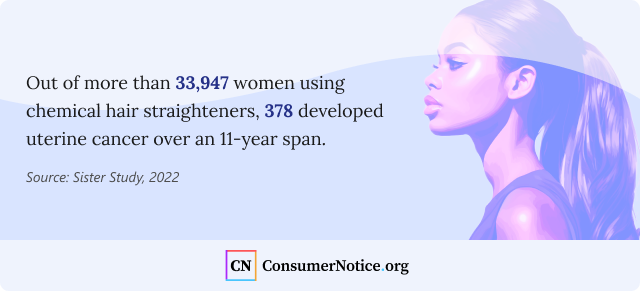
More than 33,947 women participated in the Sister Study. Researchers followed up on the participants for nearly 11 years. During that time, 378 women were diagnosed with uterine cancer.
Despite the risks, studies show some Black women feel pressured to use these potentially dangerous products on their natural hair to move up the corporate ladder or fit in with their co-workers. Others, like Amin, have chosen to wear more natural hairstyles.
“Today, I no longer jump through hoops in relation to my hair,” Amin said. “I wear it however I desire.”
Challenges of Natural-Hair Bias in the Workplace
A 2021 study named “The Natural Hair Bias in Job Recruitment” uncovered evidence of natural-hair bias against Black women in the workplace. The study was published in the journal Social Psychological and Personality Science.
Researchers in that study asked 240 Black and white women to review 8 images of Black women and 8 images of white women. Half of the photos showed Black women with natural or straight hair, and the other half showed white women with curly or straight hair.
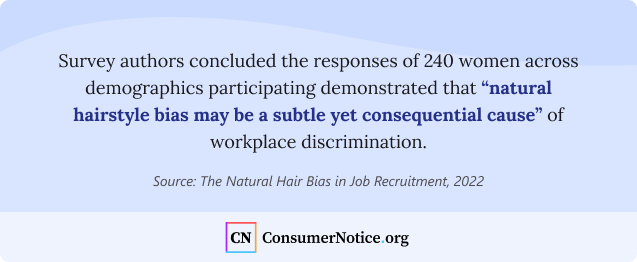
The researchers then asked all of the survey participants to rate the images they’d reviewed. Rating categories included perceived professionalism, competence and likelihood of selecting the women for a job interview.
Study authors found that “Black women with natural hairstyles were perceived to be the least professional, least competent, and least likely to be recommended for an interview across all comparison groups.”
The authors concluded that “natural hairstyle bias may be a subtle yet consequential cause” for the negative workplace outcomes Black women face, including higher unemployment rates than their white female counterparts.
Eurocentric Standards of Beauty
Appearance can be a major factor for some job recruiters, but natural hair bias goes beyond being appropriately dressed and presentable. The criteria that make someone appear professional can be difficult to pin down.
Historically, many people hold the assumption that a professional appearance should match the physical characteristics of white people, according to the workplace study’s authors. So women in the workplace, no matter their race, were expected to have straight hair rather than natural or textured hair.
For many Black women, their natural hair typically is different in texture and appearance from their white counterparts. This can cause many Black women to feel that using chemical hair straighteners or altering their hair in other ways is necessary in order to be perceived positively among employers and colleagues.
“At one of my jobs, before our professional photos were taken, I was asked when I was going to fix my hair because I was wearing braids,” said Dr. DeJarra Sims, a naturopathic doctor in California who no longer uses chemical hair straighteners. “What she meant was, when was I going to take out my braids and put straight hair on, whether that was wearing a straight hair wig or straight hair extensions?”
Effects of Workplace Hair Discrimination
Workplace hair discrimination can create several socioeconomic factors. For example, Chenadra Washington, who works in public relations in Houston, Texas, said she wore her natural hair to work one day in 2019. “Walking through the office, I felt stares from all directions,” she said.
After that, Washington said she didn’t feel comfortable wearing her natural hair to work.
- Bias: People may be overlooked for promotions, become marginalized, have limited opportunities, receive unfair treatment and be subjected to negative stereotypes.
- Economic Disparities: Limited job opportunities, lack of career advancement, fewer promotions and lower-paid positions can contribute to preexisting socioeconomic inequalities.
- Legal Implications: The CROWN Act (Creating a Respectful and Open World for Natural Hair) is legislation that protects against bias based on certain natural hairstyles. It has been enacted in a number of U.S. states.
- Mental Impact: Those who deal with natural hair bias can become overwhelmed with stress and anxiety at work. They may also have less confidence and lower self-esteem, which can greatly impact overall job satisfaction.
Hair style policies have also been an issue for the men and women who serve our country. The U.S. military has been revising its grooming standards to be more inclusive over the past several decades.
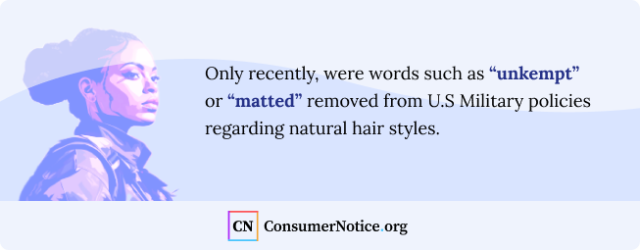
For example, the Army updated its grooming standards in 2021 to include hairstyles such as locs, braids or ponytails. The Navy began allowing men and women to wear their hair short that same year.
The Air Force relaxed its rules in 2020 to include longer hair lengths for men and women. And in 2022, the Marines began allowing longer hairstyles and the option of wearing twists in short hair.
What Is the CROWN Act?
The CROWN Act is legislation the U.S. House of Representatives passed in 2022. It seeks to ban hair discrimination based on hairstyle or hair texture.
“Natural Black hair is often deemed ‘unprofessional’ simply because it does not conform to white beauty standards,” said New Jersey Congresswoman Bonnie Watson Coleman following passage of the CROWN Act in the House. “Discrimination against Black hair is discrimination against Black people.”
- Afros
- Bantu knots
- Braids
- Cornrows
- Locs
- Tightly coiled or tightly curled hair
- Twists
Personal care company Dove found that Black women are 30% more likely to be given information about their employer’s formal grooming policy than other women, according to a 2019 study the company conducted. That same year, Dove teamed with several social justice organizations to work toward a more inclusive experience for Black men and women through the advancement of the CROWN Act.
While the CROWN Act passed the House, it did not pass the Senate and has yet to become federal law. However, several states have enacted CROWN Act legislation of their own.
California became the first state to make the CROWN Act a law in July 2019. As of June 2023, more than half of all states have filed legislation for consideration. So far, 23 states have passed the CROWN Act or other laws prohibiting discrimination based on hairstyles.
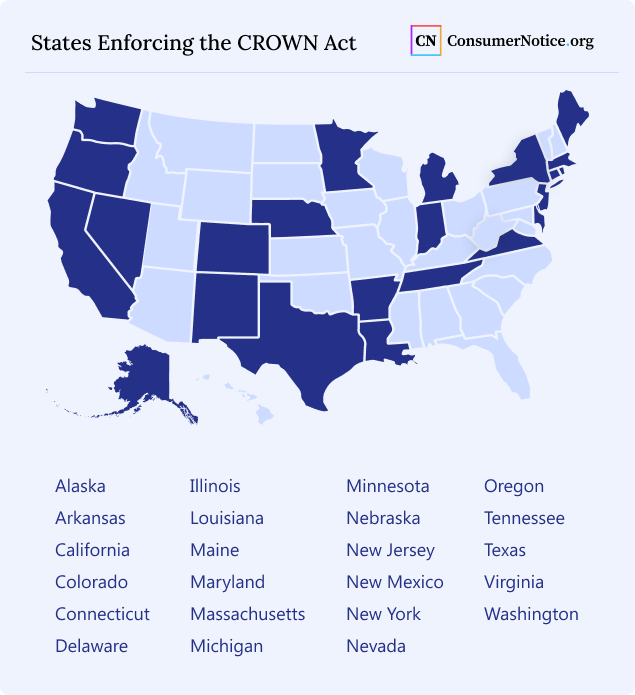
More than 30 cities, counties and municipalities across the nation, including parts of Arizona, Florida, Georgia, Kentucky, Missouri, North Carolina, Ohio, Pennsylvania, West Virginia and Wisconsin have enacted the CROWN Act. Washington, D.C., and the U.S. Virgin Islands have also passed race-based hair discrimination laws.
Chemical Hair Straighteners Lead to Pain, Injury
Chemical hair straighteners gained popularity in the 1950s. Along with the potential of chemical hair straighteners causing cancer as detailed in the Sister Study study, the products are also linked to hair damage, scalp burns and hair loss.
“Chemical exposure from hair product use, especially straighteners, could be more concerning than other personal care products due to increased absorption through the scalp which may be exacerbated by burns and lesions caused by straighteners,” according to the authors of the Sister Study.
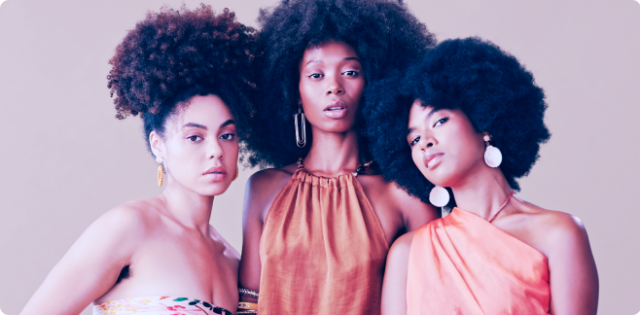
Tonya Herrell, a hairstylist in Ohio, said her customers abandoned the chemical hair straighteners because of the pain associated with their harsh chemicals. “By the ‘90s, people were getting away from using relaxers because it was noticeably breaking our hair,” she said.
Washington, the public relations professional, said she used chemical hair straighteners from the age of 9 until the age of 23 when she could no longer tolerate the pain associated with the products. “My scalp was burning so badly I never did it again,” Washington told Consumer Notice.
Timeline of Hair Straightening
The history of hair straightening is long and complex. From the groundbreaking study linking chemical hair straighteners to uterine cancer in Black women to the earliest days of hair straightening, the techniques, products and styles used to modify hair have evolved over time.
-
2022
NIH study links chemical hair straighteners to uterine cancer, and women begin filing lawsuits against hair straightener manufacturers.
-
2010
Black social media influencers show off their natural hair, creating a natural hair trend worldwide that continues today.
-
1990
Golden Age of Black sitcoms begins. Many feature women with cornrows, twists, braids or perms.
-
1970s
The Jheri curl process defines curls for natural Black hair. Sales of the perm, activator and moisturizer spike for the next decade.
-
1960s
Black women begin emulating straight hairstyles seen on Motown’s Black performers on TV.
-
1954
George E. Johnson introduces the first permanent hair straightener for men.
-
1910
Madam C. J. Walker, a Black entrepreneur, establishes the Madam C. J. Walker Manufacturing Company to produce cosmetics and hair care products for Black women.
-
1909
Sewing machine repairman Garrett A. Morgan creates the first chemical hair relaxer.
-
1900s
First hair care products marketed to Black women are introduced in the U.S.
-
1880
Hot combs arrive in America.
-
1845
France debuts hot combs or pressing combs to temporarily straighten white women’s curly hair.
Attitudes about hair straightening and popular techniques continue to shift. The impacts of the NIH study, for example, are still developing as lawsuits continue to be filed because of serious injuries and complications from chemical hair straighteners.
Long-Term Health Effects of Chemical Hair Straighteners
The use of chemical hair straighteners has been linked to negative health effects. According to the 2022 NIH study, researchers reported a connection between chemical hair straighteners and cancer. This includes a greater risk of developing bladder, breast and uterine cancers.

Hair straightening products that contain formaldehyde, also known as formalin and methylene glycol, are the most dangerous. The International Agency for Research on Cancer considers formaldehyde a human carcinogen.
Other hair straightener ingredients such as parabens and bisphenol A may also increase the risk of cancer. These chemicals and formaldehyde may all contribute to side effects, including:
- Asthma attacks
- Burning of the eyes, lungs, nose or skin
- Hair loss
- Skin conditions and rashes
- Vision impairment or vision loss
Additional research also found links between the use of permanents to curl hair and straighteners during adolescence with a higher risk of premenopausal breast cancer. Girls aged 10-13 are particularly at risk because of the potential exposure of breast tissue to the chemicals.
Rise in Chemical Hair Straightener Lawsuits
Women have filed more than 100 chemical hair straightener lawsuits since the 2022 NIH study. Daniel Nigh, a product liability expert whose law firm represents plaintiffs in chemical hair straightener lawsuits, told Consumer Notice that he sees a range of times between chemical hair straightener exposure and a cancer diagnosis.
Nigh says that on average, it takes about a decade or more after chemical hair straightener exposure to diagnose cancer. That’s especially dangerous when the Sister Study’s researchers said Black girls and women use these harsh and dangerous products more frequently and at earlier ages than other women of other races and ethnicities.
He said hair straightener companies market to Black women extensively, including young children.
“[Hair straightener products] have pictures of 6-year-old girls with their hair straight, trying to show that that’s the picture of beauty,” Nigh said. “All the while, they were being subjected to carcinogens at such a young age that would cause them to develop cancers in childbearing ages.”
Nigh expects plaintiffs will file more lawsuits. Meanwhile, hair straightener manufacturers also face class-action lawsuits. No jury verdicts or settlements have been decided. Some lawyers believe future settlements could reach up to $1.5 million.
A Tough Choice: Health or Career?
Social and economic pressures can lead some women to feel forced to decide which is more important: Health or career. Many may feel they need to use potentially harmful chemicals to straighten their hair or miss out on a job opportunity or promotion.
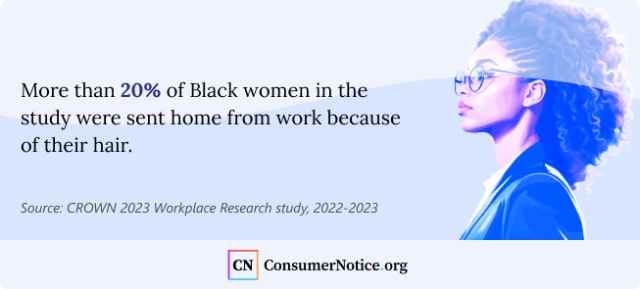
Sims, the preventative medicine specialist who faced discrimination because of her hair, said she started using chemical hair straighteners at the age of 8. She felt pressure to fit in as she pursued her career as a naturopathic doctor.
“I did not feel comfortable having a natural afro,” Sims told Consumer Notice. “African-American women have always been pressured to straighten their hair.”
Sims said she especially felt the need to use potentially dangerous chemical hair straighteners during her college years to ensure her career wasn’t sabotaged before it even began.
“My [college] advisors said, do what you have to do to get into medical school,” she said. “I was being groomed to be a doctor; they won’t accept XYZ, just do it.”
Safer Alternatives or Go Natural?
Hair stylist Herrell said fewer people use chemical hair straighteners now and prefer to go natural. She stopped using the products more than 20 years ago.
“A lot of Black women have been going natural,” Herrell said, adding that only a small percentage of her clients opt to use chemicals on their hair. “Only 3 out of 30 of my clients get relaxers.”
Maple Holistics is a personal care company that uses only plant-based ingredients for its line of health and beauty products. Caleb Backe, who works as a hair expert for Maple Holistics, agrees that natural hair is becoming a more popular option.
“In recent years, there has been a growing movement toward embracing natural hair texture and reducing reliance on chemical hair straightening methods,” Backe told Consumer Notice. “This shift is partly driven by increased awareness of the potential risks and damage associated with chemical treatments, as well as a desire for more versatile and diverse hairstyles.”
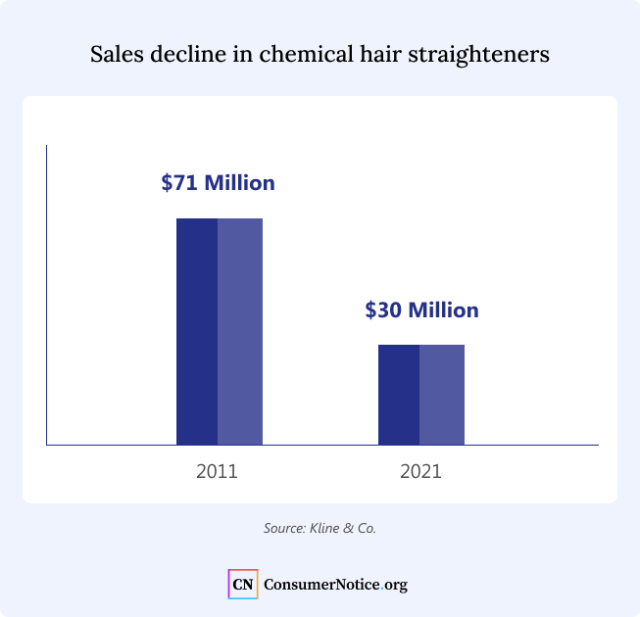
The market for chemical hair straighteners and relaxers has experienced a sharp decline in sales over the past few years. According to Forbes, industry market research firm Kline & Co. said sales of hair relaxers droppedfrom $71 million in 2011 to $30 million in 2021. Overall sales dropped 25% in 2020, which may be partially attributed to the COVID-19 pandemic.
According to Agnieszka Saintemarie, a Kline & Co. director, as sales of chemical hair straighteners continue to fall, “clients prefer more natural hairstyles and turn to styling products or styling appliances as alternatives.”
Safer Hair Straightening Options
Sales for nonchemical alternative hair straighteners are expected to grow, according to market research company Emergenresearch.com. Though the research firm does also note that the global hair straightener market is expected to keep rising at a rate of 4.8% by 2030.
Increasing sales for nonchemical solutions demonstrates there’s a market for those who want to straighten their hair without harsh chemicals, pain and potential health risks. Some ways to achieve results without putting health at risk include:
Heat
Stylists say treating hair with heat can make the hair as straight as chemicals, but the effect isn’t permanent. Using flat irons or blow dryers can also be damaging to hair. High heat needed to straighten very coily hair can be just as damaging as chemicals.
Keratin Treatments
Keratin is a protein that helps form hair, nails and epidermis. Stylists say keratin treatments are slightly less harmful to the hair compared to other straightening methods such as relaxers. Keratin will temporarily loosen curls but will eventually lose its effects, bringing the hair back to its natural state. Chemical relaxers break down the molecular bonds in hair and straighten it permanently.
Heat-Free Methods
Some stylists say methods such as air drying or hair stretching can create results without chemicals. More natural methods include hair wrapping and roller setting. These options may not create the straightness many consumers are looking for, but they are healthier options.

Future Outlook of Natural Hair in the Workplace
The CROWN Act protects natural hair in the workplace in nearly half of the country, but the legislation still has a long way to go. Aside from laws, many believe human resources departments across the U.S. need to set higher standards.
According to the HR-focused publication HR Morning, there are several options HR representatives can do right now to help ensure all employees are treated fairly in the workplace:
- Update or modify language in employee handbooks and policies.
- Ensure all language is inclusive and specific.
- Avoid terms such as “professional” or “cleanly groomed,” which are open to interpretation.
Language stating that natural hairstyles are considered professional and appropriate for the workplace can be helpful in avoiding bias. Also, providing a list of examples may better serve employees.
- Avoid making comments about a job candidate’s appearance.
- Be provided best practices training for interviewing applicants.
- Make all unacceptable workplace practices clear.
Policy changes have the potential to create a more inclusive workplace and benefit the health of women who use chemical hair straightening products. Additionally, with more alternatives for consumers, Black girls and women may be less likely to be subjected to the risks associated with hair straightening chemicals.
Lawsuits against the manufacturers of chemical hair straighteners will also raise consumer awareness about the cancer risks associated with their use. Those who experienced harm from these products seek compensation for medical costs, lost wages and other damages.
24 Cited Research Articles
Consumernotice.org adheres to the highest ethical standards for content production and references only credible sources of information, including government reports, interviews with experts, highly regarded nonprofit organizations, peer-reviewed journals, court records and academic organizations. You can learn more about our dedication to relevance, accuracy and transparency by reading our editorial policy.
- U.S. Bureau of Labor Statistics. (2023, July 7). Economic News release. Table A-2. Employment status of the civilian population by race, sex, and age. Retrieved from https://www.bls.gov/news.release/empsit.t02.htm
- Jackson, C. (2023, May 23). CROWN Act passes Michigan Senate. Retrieved from https://www.michiganradio.org/social-justice/2023-05-23/crown-act-passes-michigan-senate
- Harper’s Bazaar. (2023, March 16). Everything You Need To Know About Keratin Hair Treatments. Retrieved from https://www.harpersbazaar.com/beauty/hair/a1266/how-keratin-damages-hair/
- Warner, C. (2023, February 15). Push to end hair discrimination is growing: 3 key steps for HR to take now. Retrieved from https://www.hrmorning.com/news/hair-discrimination-at-work/
- Gonzales, M. (2023, February 7). CROWN Act: Does Your State Prohibit Hair Discrimination? Retrieved from https://www.shrm.org/resourcesandtools/hr-topics/behavioral-competencies/global-and-cultural-effectiveness/pages/crown-act-does-your-state-prohibit-hair-discrimination.aspx
- Donaldson, C. (2023). Hair Alteration Practices Amongst Black Women And The Assumption Of Self-Hatred. Retrieved from https://wp.nyu.edu/steinhardt-appsych_opus/hair-alteration-practices-amongst-black-women-and-the-assumption-of-self-hatred/
- TheCROWNact. (2023). Creating a Respectful and Open World for Natural Hair. Retrieved from https://www.thecrownact.com/
- Aziz, X. (2022, November 7). Chemical Hair Straightening Market Tanking Due to Natural Hair Movement. Retrieved from https://shinemycrown.com/chemical-hair-straightening-market-tanking-due-to-natural-hair-movement/
- Council, J. (2022, November 4). Black Women Going Natural Push Entire Industry To The Brink Of Extinction. Retrieved from https://www.forbes.com/sites/jaredcouncil/2022/11/04/black-women-going-natural-push-entire-industry-to-the-brink-of-extinction/?sh=2e4069fb1434
- Karimi, F. (2022, October 22). When it comes to their hair, Black women face a difficult choice. Retrieved from https://www.cnn.com/2022/10/22/health/hair-straighteners-cancer-black-women-cec/index.html
- Chang, C.J. et al. (2022, October 17). Use of Straighteners and Other Hair Products and Incident Uterine Cancer. Retrieved from https://academic.oup.com/jnci/article/114/12/1636/6759686
- Enokenwa, M.G. et al. (2022, October 17). Military Grooming Standards and Black Hairstyling Practices. Retrieved from https://academic.oup.com/milmed/advance-article-abstract/doi/10.1093/milmed/usac313/6762165
- Simeon, A. (2022, October 11). It's Time to Learn the History Behind The Silk Press. Retrieved from https://www.byrdie.com/silk-press-history-5199277#toc-the-history
- Emergenresearch. (2022,September) Straighteners Market By Material Type (Ceramic, Titanium, and Tourmaline), By Device Type (Hair and Beard), By End-Use (Household and Commercial) By Sales Channel (Online and Offline), and By Region Forecast to 2030. Retrieved from https://www.emergenresearch.com/industry-report/straighteners-market
- Congress. (2022, March 18). H.R.2116 – Creating a Respectful and Open World for Natural Hair Act of 2022. Retrieved from https://www.congress.gov/bill/117th-congress/house-bill/2116/text
- Griffith, J. (2022, March 18). House passes Crown Act banning discrimination against Black hairstyles. Retrieved from https://www.nbcnews.com/politics/politics-news/house-passes-crown-act-banning-discrimination-black-hairstyles-rcna20617
- Office of Representative Bonnie Watson Coleman. (2022, March 18). Watson Coleman Celebrates House Passage of the CROWN Act. Retrieved from https://watsoncoleman.house.gov/newsroom/press-releases/watson-coleman-celebrates-house-passage-of-the-crown-act
- FDA. (2022, February 25). Hair Smoothing Products That Release Formaldehyde When Heated. Retrieved from https://www.fda.gov/cosmetics/cosmetic-products/hair-smoothing-products-release-formaldehyde-when-heated
- Koval, C.Z. et al. (2021, August 19). The Natural Hair Bias in Job Recruitment. Retrieved from https://journals.sagepub.com/doi/abs/10.1177/1948550620937937?journalCode=sppa
- Booker, K. (2014, February 21). A History Of Black Hair In America. Retrieved from https://www.refinery29.com/en-us/black-hair-history
- Kyle, D.J. et al. (1996, September). The Effects Of Hair Color And Cosmetic Use On Perceptions Of A Female's Ability. Retrieved from https://journals.sagepub.com/doi/10.1111/j.1471-6402.1996.tb00311.x
- IzzyandLiv.com. (n.d.). Timeline: The Evolution of Black Hair. Retrieved from https://www.izzyandliv.com/blogs/stuff-we-love/timeline-the-evolution-of-black-hair
- NAACP Legal Defense Fund. (n.d.). Natural Hair Discrimination Frequently Asked Questions. Retrieved from https://www.naacpldf.org/natural-hair-discrimination
- PACER. (n.d.). Pacer Case Locator. Retrieved from https://pcl.uscourts.gov/pcl/index.jsf
Calling this number connects you with a Consumer Notice, LLC representative. We will direct you to one of our trusted legal partners for a free case review.
Consumer Notice, LLC's trusted legal partners support the organization's mission to keep people safe from dangerous drugs and medical devices. For more information, visit our partners page.
866-461-6220